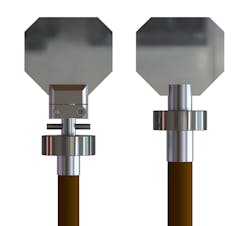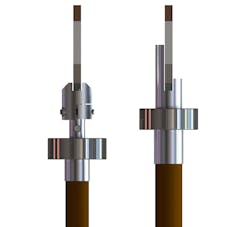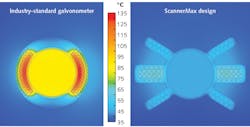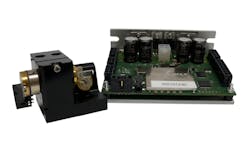Optical Scanning: Scanning advances brighten and enhance laser light shows

JUSTIN PERRY
Optical scanners used to direct, position, or "scan" a laser beam over a desired area are in widespread use throughout the industrial, medical, and entertainment laser industries. Recent advances in galvanometer-based optical scanners can deliver dramatically improved results for laser systems, enhancing the experience for laser light show patrons.
Since light beams are only influenced by refraction, diffraction, or reflection, optical scanners have been developed to take advantage of each of these methods. So, in a broad sense, they can be classified as one of three types: acousto-optic scanners that deflect a beam using diffraction; electro-optic scanners that deflect a beam using refraction; and mechanical scanners (resonant, polygonal, and galvanometer scanning types) that deflect a beam using reflection. While all of these scanner types have been in use for decades, galvanometric scanners in the third group have significant benefits.
Acousto-optic and electro-optic scanners
With scanning speeds somewhat beyond 100 kHz, acousto- and electro-optic scanners can rapidly scan beams in random directions. However, their scan angle is typically limited to a few degrees or less, and often these scanners cannot be used with more than one wavelength simultaneously. The optical throughput of acousto-optic scanners is also limited to around 80% or less for a single axis, disqualifying them from laser light show venues.
Resonant and polygonal scanners
On the other hand, mechanical scanners work by rotating a physical mirror that can be coated to reflect any wavelength or combination of wavelengths with very high reflectivity—and thus, high optical throughput.
Using that physical mirror, both resonant and polygonal scanners can be made to scan a beam over very wide angles, but having the limitation of scanning the same pattern over and over again. For some applications such as printing, this is highly desirable, but for applications that require scanning of non-repeated patterns or positioning of a beam over a random area, the galvanometer scanner is the only choice.
Galvanometer scanners
Called galvos for short, mechanical galvanometer-based scanners involve a physical mirror operated by a motor of some kind. Most often, the mirror is attached to the shaft of the motor, but in some designs the mirror and motor may be a single integral unit.
Rather than simply spinning around, galvo motors are specialized and able to rotate over a limited range of angles (typically around ± 20°). Galvo motors also incorporate a high-precision position detector that provides feedback to a separate controller, delivering pointing repeatability of 5 μrad (5 mm at a distance of 1 km).
Galvos and virtually all mechanical scanners reflect the beam off of the rotating mirror such that the achievable scan angle in optical degrees is double the actual motor rotation angle. For galvos, this means that they can project beams up to 80° peak-to-peak or even more, and can be configured for two-axis scanning relatively easily.
Galvo limitations
For all of their benefits, including very wide scan angle, ability to scan multi-wavelength beams, high precision, and nearly 100% optical throughput, galvos do have a downside: speed. As mechanical scanners that impart real motion onto a physical mirror, galvos are limited by the laws of physics. Generally, this means that they have been relegated to scan frequencies between a few-hundred hertz and a few kilohertz.
And although physics can dictate how fast the physical mirror can be moved because of the force (torque) generated by the motor and the mass (inertia) of the mirror, it is not always obvious that other laws of physics dictate how fast the motor and mirror can be moved before being overcome by resonances. Very often, resonances in the system cause projected images to become distorted long before the motor has run out of the torque that could have produced greate r scanning speeds.
Galvanometer evolution
A flurry of galvo scanner developments and patents started around 1976. These early designs involved the use of stationary Alnico magnets and "moving-iron" rotors. Indeed, moving-iron galvanometers had pretty good commercial success in strip-chart recorders, laser entertainment displays, and early laser marking machines.
Moving-iron galvos are generally hard-to-break, robust instruments. However, their relatively high electrical inductance and the magnetic circuit that allows the moving iron rotor to become saturated with magnetic flux places a hard upper limit on the amount of torque that can be developed. Although rotor stiffness (and thus the possibility to excite rotor and mirror resonance) is also lacking, moving-iron galvos were the tool of choice for around 20 years following their introduction.
Moving-coil galvos have also existed in one form or another for decades, with the earliest devices used in the 1900s. In the 1970s and 1980s, moving-coil galvos were also found in very specialized optical strip chart recorders, and throughout the 1990s were used in some laser marking machines. While still in use in specialized applications, they have never reached the degree of success of moving-iron galvos or of the next evolutionary step—the moving-magnet galvo.
Moving-magnet galvos
In 1992, galvo manufacturers started producing "moving-magnet scanners," so named because the rotor is made of a cylindrical magnet. Although moving magnet designs were conceived and patented in 1976, they were not practical until neodymium "super magnets" were developed in the late 1980s.
Because of the way the coil is formed inside the motor and where it is placed in the magnetic circuit, moving-magnet galvos have around 10X less electrical inductance than moving-iron galvos. Moreover, because there are no small, thin paths in the magnetic circuit, the magnetic saturation effects of moving-iron galvos are nonexistent, meaning that the laws of physics related to torque production are greatly alleviated—especially when short bursts of motion are used, as in laser marking applications.
Unfortunately, moving-magnet galvos do not solve all motor-related problems. When an application demands long periods of both high speed and wide-angle motion, the conventional moving-magnet motor construction is prone to overheating, as well as causing mirror flexing and resonance issues during scanning. And while advanced mirror materials such as silicon, silicon carbide, and beryllium can partially alleviate these resonance-related issues, access to these materials is limited and scanning system costs are increased while scanning speeds suffer.
A new formula
Frustrated by the stagnation in galvanometric scanning speeds, Pangolin president and chief engineer William R. Benner, Jr. began conceiving and developing scanners that would overcome the limitations of the conventional moving-magnet galvanometer. University professors who had written books on motor design as well as jet-airliner rotor design experts were brought in to analyze magnet/shaft/mirror interactions to identify the best possible combination of materials, shapes, and construction techniques.
After fine-tuning tens of thousands of design iterations in a computer using finite-element analysis techniques and building dozens of prototypes that resulted in a dozen patents with many of them already granted, Pangolin started a new division called ScannerMAX to manufacture its namesake galvo scanner.
Essentially, these galvos are stronger and cooler, tackling two primary barriers that limit performance. First, as scanning speed is increased further and further, everything that rotates (the magnet, bearings, and any mirror mount) will become unstable, resulting in projected image distortion. And second, as more and more current is pumped into the galvo motor to produce more torque, heat is generated at a geometric rate. Since the motor can only take so much heat before destruction results, this places an upward limit on the amount of constant torque that can be produced by the motor.
Stronger galvos
Conventional galvos have an output shaft whose diameter is typically much smaller than the magnet. Manufacturers most often drill a hole through that small shaft, into which they place a "stopping pin" that limits the amount of motor rotation. Unfortunately, this means that the shaft must be made longer to accommodate the stopping pin, and is weakened by the hole accommodating the pin. A separate mirror mount is then used as an interface between the shaft and the mirror, thus adding to the distance between the magnet and the mirror.
In this case, the mirror mount typically only grips around 1 mm or less of the bottom edge of the mirror. With mirrors for scanning 10 mm laser beams being typically 24 mm long, this means that only 1/24th of the mirror is being supported by the mirror mount—a sub-optimal architecture that is fertile territory for resonances to occur. And although a notch filter is almost always needed in the servo driver to try to control the resonances, these filters also add phase delay in the servo loop and tend to affect the purity of the mirror motion.
The construction of ScannerMAX is different. The output shaft is typically the same diameter as that of the magnet, and since shaft stiffness is proportional to the fourth power of diameter, the stiffness increase based on diameter alone is more than 5X that of a conventional galvo. In addition, it uses no stopping pin and therefore needs no stopping hole, making the shaft as short as possible with no internal voids for maximum stiffness (see Fig. 1).
To limit motor rotation without a stopping hole, the scanner uses a patent-pending external mirror bumper. The mirror is then mounted directly into a slot in the shaft, so no separate mirror mount is used. Using this rotor technique, the distance between the magnet and the mirror (a factor that ultimately dictates resonances) is dramatically shorter.
Finally, the interface between the mirror and the shaft is not a simple slot, but rather one that includes a "back support." We liken this to the difference between sitting on a chair with a back and sitting on a barstool. The increased stiffness of all rotor components and improved mirror support system means that a notch filter is not needed in the servo loop, simplifying the servo design while also promoting very smooth and pure mirror motion.
Cooler galvos
Conventional galvos are constructed as a circular steel outer shell with copper wires placed between the steel and the concentric magnet. This leads to a variety of limitations, including the amount of flux density in the air gap because of the tradeoff between coil and air space, and the amount of heat that can be removed from the motor.
Alternatively, ScannerMAX uses copper wire between slots located within steel laminations in such a way that the air gap is significantly reduced and the flux density of the system is greatly increased (see Fig. 2). The slots also allow the use of thicker copper wire, lowering coil resistance.With the increased flux density between the magnet and the steel, fewer turns of copper wire are needed to create the same amount of torque, allowing the motor to run much cooler than conventional galvos. These scanners are typically around 1/3 to 1/2 that of conventional galvos while delivering the same torque. And since heat in the galvo is directly proportional to coil resistance, they run much cooler for a given amount of torque production or, conversely, produce greater torque for a given amount of heat (see Fig. 3).
In addition to projection displays, we believe the biggest beneficiary of this technology will be biomedical researchers performing confocal microscopy and optical coherence tomography since these applications have up to now depended on the current generation of conventional galvanometers that have a relatively short lifetime because of the heat produced during the scanning action.
Justin Perry is chief operating officer of Pangolin Laser Systems, Orlando, FL; e-mail: [email protected]; http://pangolin.com.


